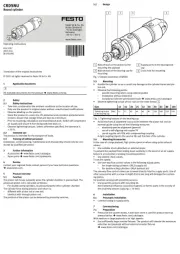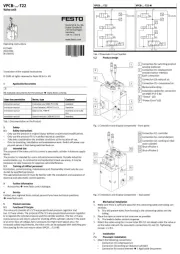Festo EGSC-BS-KF-45-100-10P Bedienungsanleitung
Festo
Nicht kategorisiert
EGSC-BS-KF-45-100-10P
Lies die bedienungsanleitung für Festo EGSC-BS-KF-45-100-10P (5 Seiten) kostenlos online; sie gehört zur Kategorie Nicht kategorisiert. Dieses Handbuch wurde von 4 Personen als hilfreich bewertet und erhielt im Schnitt 4.7 Sterne aus 2.5 Bewertungen. Hast du eine Frage zu Festo EGSC-BS-KF-45-100-10P oder möchtest du andere Nutzer dieses Produkts befragen? Stelle eine Frage
Seite 1/5

EGSC-BS
Mini slide
Festo SE & Co. KG
Ruiter Straße 82
73734 Esslingen
Deutschland
+49 711 347-0
www.festo.com
Operating instructions
8166189
2021-12e
[8166191]
Translation of the original instructions
© 2022 all rights reserved to Festo SE & Co. KG
1
Applicable Documents
All available documents for the product
è
www.festo.com/sp.
2 Safety
2.1 Safety instructions
–
Observe labelling on the product.
–Before working on the product, switch off the power supply and secure it
against being switched on again.
–
Store the product in a cool, dry environment protected from UV and corrosion.
Keep storage times short.
–
Store the product in ambient conditions without oils, greases and grease-dis-
solving vapours.
2.2 Intended use
The mini slide is intended to be used for positioning payloads in combination with
tools.
The mini slide is only approved for slide operation.
Fig. 1:
Slide operation
2.3 Training of qualified personnel
Work on the product may only be carried out by qualified personnel who can
evaluate the work and detect dangers. The qualified personnel have knowledge
and experience in dealing with electric drive systems.
3 Additional information
–
Contact the regional Festo contact if you have technical problems
è
www.festo.com.
–
Accessories and spare parts
è
www.festo.com/catalogue.
4 Product overview
4.1
Function
The mini slide converts the rotary motion of the mounted motor into a linear
motion of the slide. The screw drive converts the torque of the motor into a feed
force. The linear movement of the slide is precisely guided by the guide. Sensors
monitor end positions, reference position and intermediate position.
4.2 Product design
1
2
3
4
5 6 7 8 9 10 11 12
13
14
15
16
17
Fig. 2: Product design EGSC-BS
1
Through-hole and centring hole
2
Centring hole for attachment
component
3
Yoke plate
4
Hole for accessories
5
Threaded hole for attachment
component
6
Centring hole for attachment
component
7
Slide
8
Piston rod
9
Guide rail
10
Sealing air connection with filter
element
11
Interface for motor mounting kit
12
Drive hub
13
Slot for sensor bracket
14
Threaded hole for switch lug
15
Slot for profile mounting
16
Thread and centring hole for
direct fastening
17
Cylinder profile
5
Transport
NOTICE
Unexpected and unbraked movement of components
• Secure moving components for transport.
–Store and transport the product in its original packaging. Observe the weight,
the dimensions and the ambient conditions.
–
Take the centre of gravity of the product into consideration.
–Store and transport the product in a horizontal position.
6
Assembly
6.1 Safety
WARNING
Risk of Injury due to Unexpected Movement of Components
For vertical or slanted mounting position: when power is off, moving parts can
travel or fall uncontrolled into the lower end position.
•
Bring moving parts of the product into a safe end position or secure them
against falling.
6.2 Unpacking product
1. Open packaging.
2. Remove all transport materials, e.g. foils, caps, cardboard boxes.
3. Remove the product from the packaging and place it on the mounting surface.
4.
Dispose of packaging and transport materials.
6.3
Mounting the motor
Transverse load on the drive hub
When mounting the motor and motor mounting kit, do not exceed the maximum
transverse load F
R
of the drive hub, e.g. toothed belt tension when mounting the
parallel kit
è
12.1 Technical data, mechanical.
Axial kit EAMM-A Parallel kit EAMM-U
Tab. 1:
Overview of motor mountings

Requirement
–Only loosen screws or threaded pins that are described in the directions in the
instruction manuals.
–
Sufficient space for reaching and securing the sealing air connection
è
6.6
Mounting accessories.
1. Select the motor and motor mounting kit from
Festo
è
www.festo.com/catalogue.
If other motors are used: observe the critical limits for forces, torques and
velocities.
2.
Fasten motor mounting kit, observe instruction manual
è
www.festo.com/sp.
3. Fasten the motor without tension. Support large and heavy motors.
Connect motor cables only on completion of mounting.
6.4
Mounting mini slide
Requirement
–No collision in the range of motion of the attachment component with motor,
mounting components and sensor components.
–Sufficient space for reaching and securing the sealing air connection.
–Flatness of the mounting surface of 0.05% of the stroke length or maximum
0.2 mm over the stroke length of the bearing surface.
–No distortion or bending when installing the product.
1. Select mounting attachments
è
www.festo.com/catalogue.
2. Direct fastening: remove rubber cover caps from centring holes or threaded
holes.
3. Direct fastening: place centring components in the centring holes.
Profile mounting: place mounting attachments on the support points.
4.
Tighten retaining screws.
Observe the maximum tightening torque and screw-in depth.
For additional information, contact your local Festo Service.
Direct mounting Profile mounting EAHF-L2
Mounting via thread Mounting via profile groove
Tab. 2:
Overview of mounting components
Size 25 32 45 60
Direct mounting
Screw M3 M4 M5 M5
Max. screw-in depth t
max
[mm] 6 8.5 7 8
Max. tightening torque [Nm] 1.4 3.2 3 3
Centring hole and centring element,
centre
[mm] 2 4 5 7Æ Æ Æ Æ
Centring hole and centring element, out-
side
[mm] 5 7 7 7Æ Æ Æ Æ
Centre hole tolerance H7
Profile mounting EAHF-L2
Screw Instruction manual
è
www.festo.com/sp.
Tab. 3:
Information for mounting components
6.5 Mounting the attachment component
Collision-free Flatness Guide load Max. screw-in
depth
Tab. 4:
Requirement for attachment components
Requirement:
–
No collision in the range of motion of the attachment component with motor,
mounting components and sensor components.
–Flatness of the mounting surface of the attachment component of 0.01 mm
above the slide surface.
–
Minimise guide load. Short lever arms from the guide centre
to the force
application points and centres of gravity of the add-on elements.
1. Select accessories
è
www.festo.com/catalogue.
2. Place centring components in centring holes.
3. Position the attachment component on the slide or yoke plate.
4.
Tighten retaining screws.
Observe the maximum tightening torque and screw-in depth.
Direct mounting
Yoke plate Slide
Mounting via through-hole Mounting via thread (only mount on marked sur-
face)
Tab. 5: Overview of attachment components
Size 25 32 45 60
Direct fastening of yoke plate
Screw M3 M4 M5 M5
Centring hole and centring element,
centre
[mm] 2 4 5 7Æ Æ Æ Æ
Centring hole and centring element, out-
side
[mm] 5 7 7 7Æ Æ Æ Æ
Centre hole tolerance, centre H8
Centre hole tolerance, outside H7
Direct fastening on slide
Screw M3 M4 M5 M5
Max. tightening torque [Nm] 1.5 2.7 5.1 6.5
Max. screw-in depth t
max
[mm] 4.5 5 6 8
Centring hole and centring element [mm] 2 4 5 7Æ Æ Æ Æ
Centre hole tolerance H7
Tab. 6: Information on attachment components
6.6 Mounting accessories
Requirement
–No collision in the range of motion of the attachment component with motor,
mounting components and sensor components.
Function
–
Protection against uncontrolled overtravel of the end positions.
–Referencing to reference switch or end position.
–
Query of end positions or intermediate positions.
–Prevention of hard impacts at the end positions.
–
Prevention of contamination in the slots.
1. Select accessories
è
www.festo.com/catalogue.
2. Mount sensor for reference or query:
–
Mount sensor bracket and switch lug.
–Align sensor and mount it at the switching position.
–
Fasten cable.
Instruction manuals
è
www.festo.com/sp.
Sensor bracket EAPM and switch lug EAPM
–
Switch lug: mounting on slide
–Sensor bracket: mounting via profile groove
–
Protect the sensor from external magnetic or
ferritic influences, e.g. min. 10 mm distance
to slot nuts.
–Preferably use hardware limit switches with
N/C contact function to ensure protection in
the event of a sensor failure.
–Query switching lug only with inductive
sensor.
Instruction manual
è
www.festo.com/sp
Tab. 7:
Overview of sensor mountings

Connecting sealing air
The use of sealing air at approx. ± 0.02 MPa (± 0.2 bar, ± 2.9 psi) reduces or
prevents subsequent contamination:
–
The application of negative pressure minimises the release of abraded particles
into the environment.
–
The application of overpressure reduces the penetration of dirt into the
drivetrain.
Fig. 3: Mounting fitting
1. Remove the filter element from the threaded hole.
2. Mount the screw fitting and connect the hose.
Size 25 32 45 60
Thread M5 M5 G 1/8 G 1/4
Max. screw-in depth [mm] 4 5 7 7
Max. tightening torque [Nm] 1.4 1.4 5 8
Tab. 8: Information on sealing air connection
7 Commissioning
7.1 Safety
WARNING
Risk of injury due to unexpected movement of components.
• Protect the positioning range from unwanted intervention.
• Keep foreign objects out of the positioning range.
•
Perform commissioning with low dynamic response.
7.2 Performing commissioning
Block-shaped acceleration profiles without jerk limitation can have the following
effects:
• High mechanical loads on the lead screw due to high force peaks.
• Overshooting effects during positioning.
• Rise of the entire system.
Recommendation: reduce high force peaks in the acceleration and deceleration
phases by using the jerk limitation.
When the motor is removed, the motor encoder loses its absolute reference to the
reference mark, e.g. by turning the motor drive shaft.
• Carry out a homing run every time the motor is mounted in order to establish
the absolute reference between the motor encoder and the reference mark.
Running noises during operation
Identically constructed sliding drives can generate different running noises
depending on the parameterisation, mode of operation, type of mounting, instal-
lation environment and components.
For use with reduced particle emission
Clean product
è
9.3 Cleaning.
Requirement
–Mounting of the drive system s checked.
–
Installation and wiring of the motor is checked.
–No foreign objects in the movement space of the drive system.
–
Maximum permissible feed force and drive torque not exceeded as a function
of acceleration, deceleration (e.g. stop function, quick stop), velocity, moving
mass and mounting position.
–Mini slide not mechanically overloaded and dynamic setpoint deviation not
exceeded due to force and torque peaks or overshoot effects, e.g. overrunning
the end position.
Limit overloads and overruns by jerk limitation, reduced acceleration and decel-
eration setpoints or optimised controller settings.
–Control run and reference run with reduced speed setpoints, acceleration set-
points and deceleration setpoints.
–No test run to mechanical end stops.
–
Software end positions ≥ 0.25 mm away from the mechanical stops.
Steps Purpose Note
1. Check
travel
Determining the
direction of travel of
the slide
–
Direction of movement of the slide, clockwise spindle:
–Retracting: rotate drive shaft clockwise.
–Advancing: rotate drive shaft anti-clockwise.
–The direction of movement of the slide for positve and
negative position values depends on the mounting posi-
tion of the motor on the slide, e.g. parallel kit or axial kit.
–Set a required reversal of direction of rotation via param-
eters in the servo drive or controller.
2. Homing Determination of
the reference point
and adjustment of
the dimensional ref-
erence system
–during the initial
start-up proce-
dure
–after replacement
of the motor
Permissible reference points:
–towards reference switch:
Travel at reduced velocity
è
12 Technical data.
–towards end position:
do not exceed maximum values
è
Tab. 10 Speed and
energy at the end positions.
Additional information Instruction manual of the driveè
system
è
www.festo.com/sp.
3. Test run Checking the oper-
ating conditions
Check application requirements:
–Slide travels through the complete travel cycle in the
specified time.
–The slide stops travel when a limit switch or software end
position is reached.
After a successful test run, the drive system is ready for operation.
Tab. 9:
Commissioning steps
Size 25 32 45 60
Max. stop velocity [m/s] 0.01
Max. stop energy [mJ] 0.005 0.009 0.014 0.044
Calculation of the maximum stop energy
•
!"
=#
$
%
2
#&m#+#
'
(
'
)
*
–
v = max. stop velocity
–m = mass of all linear moving components
–J
R
= mass moment of inertia of all rotating compo-
nents
–J
L
= mass moment of inertia per kg payload
Additional information
è
www.festo.com/catalogue.
Tab. 10:
Speed and energy at the end positions
8
Operation
WARNING
Risk of injury due to unexpected movement of components.
• Protect the positioning range from unwanted intervention.
• Keep foreign objects out of the positioning range.
•
Perform commissioning with low dynamic response.
Lubrication run during operation
Observe the following lubrication travel intervals.
• With working stroke less than 2 x spindle pitch... P:
•
Perform a lubrication run within 10 travel cycles with a minimum stroke of
≥ 2 x spindle pitch.
9 Maintenance
9.1
Safety
WARNING
Unexpected movement of components.
Injury due to impacts or crushing.
• Before working on the product, switch off the control and secure it to prevent it
from being switched back on accidentally.
9.2 Checking slide elements
Checking reversing backlash
• Check the reversing backlash (reversal error) of the slide at every mainte-
nance interval, e.g. lubrication interval.
If the maximum permissible reversing backlash is exceeded, the slide should
be replaced.
Size 25 32 45 60
Max. permissible reversing backlash [mm] 0.15£
Tab. 11:
Maximum permissible reversing backlash
9.3 Cleaning
–If the piston rod is dirty, clean it with a clean, soft and lint-free cloth without
cleaning agents and then apply the lubricant thinly to the piston rod.
–Clean the other product components with a clean, soft cloth and non-abrasive
cleaning agents.
For use with reduced particle emission:
–
Remove abrasion and contamination from the product on the following
schedule:
–Prior to initial commissioning.
–
Regularly during operation.
Produktspezifikationen
| Marke: | Festo |
| Kategorie: | Nicht kategorisiert |
| Modell: | EGSC-BS-KF-45-100-10P |
Brauchst du Hilfe?
Wenn Sie Hilfe mit Festo EGSC-BS-KF-45-100-10P benötigen, stellen Sie unten eine Frage und andere Benutzer werden Ihnen antworten
Bedienungsanleitung Nicht kategorisiert Festo
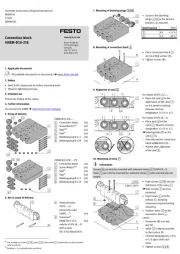
24 Juli 2025
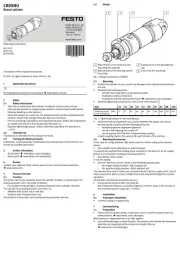
24 Juli 2025
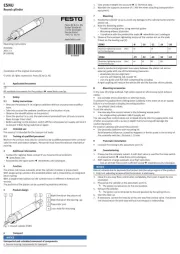
23 Juli 2025
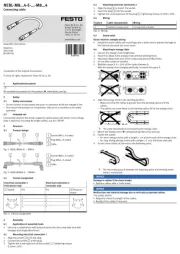
23 Juli 2025
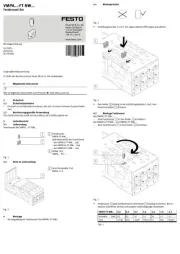
23 Juli 2025
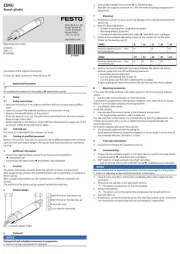
23 Juli 2025
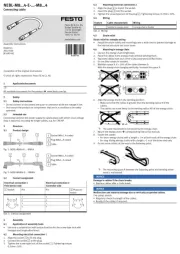
23 Juli 2025
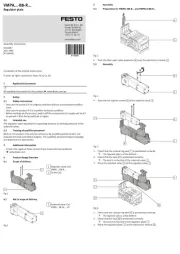
23 Juli 2025
Bedienungsanleitung Nicht kategorisiert
- Fitbit
- Blaze
- Endorphin.es
- HQ
- Gudsen
- Stromer
- IQAir
- Dörr
- ChamSys
- SPT
- Atmotube
- Cubot
- TS Electronic
- KERN
- DuroStar
Neueste Bedienungsanleitung für -Kategorien-
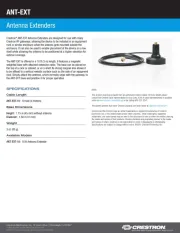
31 Juli 2025
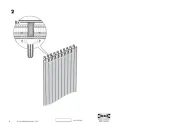
31 Juli 2025

31 Juli 2025
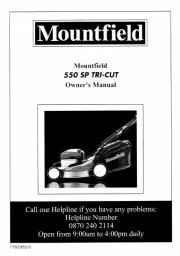
31 Juli 2025
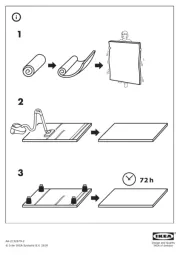
31 Juli 2025
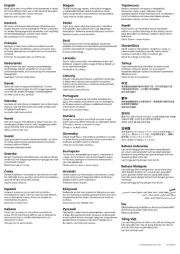
31 Juli 2025
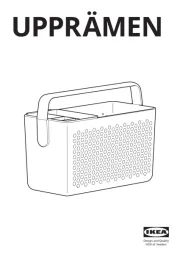
31 Juli 2025

31 Juli 2025

31 Juli 2025
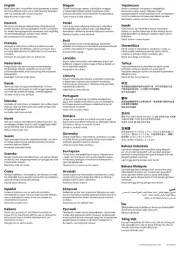
31 Juli 2025
